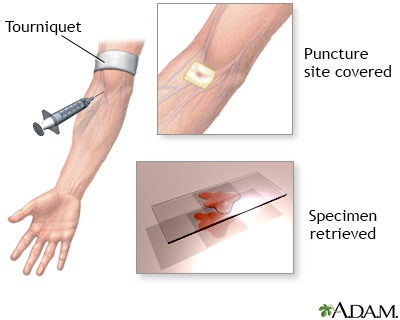Splinter hemorrhages
Fingernail hemorrhageSplinter hemorrhages are small areas of bleeding (hemorrhage) under the fingernails or toenails.
Considerations
Splinter hemorrhages look like thin, red to reddish-brown lines of blood under the nails. They run in the direction of nail growth.
They are named splinter hemorrhages because they look like a splinter under the fingernail. The hemorrhages may be caused by tiny clots that damage the small capillaries under the nails.
Splinter hemorrhages can occur with infection of the heart valves (endocarditis). They may be caused by vessel damage from swelling of the blood vessels (vasculitis) or tiny clots that damage the small capillaries (microemboli).
Endocarditis
Endocarditis is inflammation of the inside lining of the heart chambers and heart valves (endocardium). It is most often caused by a bacterial or, r...

Vasculitis
Hypersensitivity vasculitis is an extreme reaction to a medicine, infection, or foreign substance. It leads to inflammation and damage to blood vess...

Causes
Causes may include:
- Bacterial endocarditis
- Injury to the nail
Home Care
There is no specific care for splinter hemorrhages. Follow your health care provider's instructions for treating endocarditis.
When to Contact a Medical Professional
Contact your provider if you notice splinter hemorrhages and you haven't had any recent injury to the nail.
Splinter hemorrhages most often appear late in endocarditis. In most cases, other symptoms will cause you to visit your provider before splinter hemorrhages appear.
What to Expect at Your Office Visit
Your provider will examine you to look for the cause of splinter hemorrhages. You may be asked questions such as:
- When did you first notice this?
- Have you had an injury to the nails recently?
- Do you have endocarditis, or does your provider suspect that you have endocarditis?
- What other symptoms do you have, such as shortness of breath, fever, general ill feeling, or muscle aches?
The physical exam may include special attention to the heart and blood circulation systems.
Laboratory studies may include:
-
Blood cultures
Blood cultures
A blood culture is a laboratory test to check for bacteria or other germs in a blood sample.
 ImageRead Article Now Book Mark Article
ImageRead Article Now Book Mark Article -
Complete blood count (CBC)
Complete blood count
A complete blood count (CBC) test measures the following:The number of white blood cells (WBC count)The number of red blood cells (RBC count)The numb...
 ImageRead Article Now Book Mark Article
ImageRead Article Now Book Mark Article -
Erythrocyte sedimentation rate (ESR)
Erythrocyte sedimentation rate
ESR stands for erythrocyte sedimentation rate. It is commonly called a "sed rate. "It is a test that indirectly measures the level of certain protei...
 ImageRead Article Now Book Mark Article
ImageRead Article Now Book Mark Article
In addition, your provider may order:
-
Chest x-ray
Chest x-ray
A chest x-ray is an x-ray of the chest, lungs, heart, large arteries, ribs, and diaphragm.
 ImageRead Article Now Book Mark Article
ImageRead Article Now Book Mark Article - Electrocardiogram (ECG)
ECG
An electrocardiogram (ECG) is a test that records the electrical activity of the heart.
 ImageRead Article Now Book Mark Article
ImageRead Article Now Book Mark Article -
Echocardiogram
Echocardiogram
An echocardiogram is a test that uses sound waves to create pictures of the heart. The picture and information it produces is more detailed than a s...
 ImageRead Article Now Book Mark Article
ImageRead Article Now Book Mark Article
After seeing your provider, you may want to add a diagnosis of splinter hemorrhages to your personal medical record.
References
Lipner SR, Scher RK. Nail signs of systemic disease. In: Callen JP, Jorizzo JL, Zone JJ, Piette WW, Rosenbach MA, Vleugels RA, eds. Dermatological Signs of Systemic Disease. 5th ed. Philadelphia, PA: Elsevier; 2017:chap 44.
Tosti A. Diseases of hair and nails. In: Goldman L, Cooney KA, eds. Goldman-Cecil Medicine. 27th ed. Philadelphia, PA: Elsevier; 2024:chap 409.
Wright WF. Fever of unknown origin. In: Bennett JE, Dolin R, Blaser MJ, eds. Mandell, Douglas, and Bennett's Principles and Practice of Infectious Diseases. 9th ed. Philadelphia, PA: Elsevier; 2020:chap 56.
Review Date: 7/8/2023
Reviewed By: Linda J. Vorvick, MD, Clinical Professor, Department of Family Medicine, UW Medicine, School of Medicine, University of Washington, Seattle, WA. Also reviewed by David C. Dugdale, MD, Medical Director, Brenda Conaway, Editorial Director, and the A.D.A.M. Editorial team.






